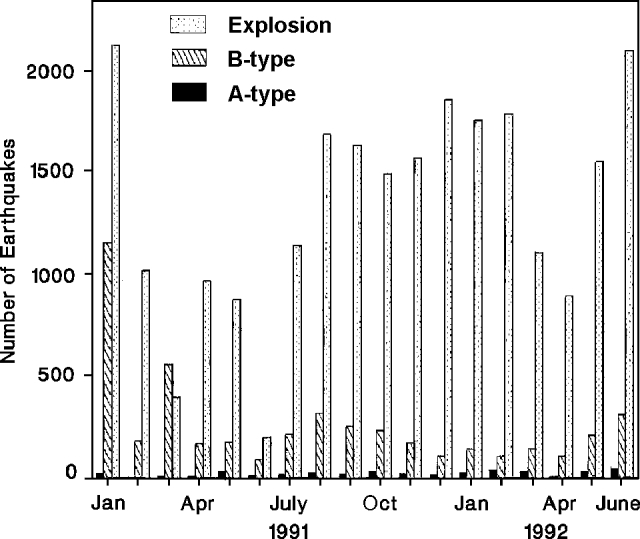Report on Marapi (Indonesia) — June 1992
Bulletin of the Global Volcanism Network, vol. 17, no. 6 (June 1992)
Managing Editor: Lindsay McClelland.
Marapi (Indonesia) Explosion kills one person and injures five others
Please cite this report as:
Global Volcanism Program, 1992. Report on Marapi (Indonesia) (McClelland, L., ed.). Bulletin of the Global Volcanism Network, 17:6. Smithsonian Institution. https://doi.org/10.5479/si.GVP.BGVN199206-261140
Marapi
Indonesia
0.38°S, 100.474°E; summit elev. 2885 m
All times are local (unless otherwise noted)
An explosion on 5 July killed one person and injured five others. Marapi has been erupting since 1987, with explosions typically occurring about once every 1-7 days. Material ejected by the smaller explosions rises 100-800 m, whereas ejecta from larger explosions reach 800-2,000 m above the summit. The recent explosions, which produce ash and lapilli, have originated from Verbeek Crater in the summit complex. Ashfalls have been frequent NW of the volcano in Bukittinggi (roughly 15 km NW of the summit), Sungai Puar (30 km NW), and the Agam district (>30 km NW), depending on wind direction. Fluctuations in Marapi's explosions seem to parallel shallow volcanic earthquakes (figure 2), suggesting that the activity is primarily caused by degassing from a relatively shallow source through an open vent.
 |
Figure 2. Number of explosion, A-, and B-type earthquakes at Marapi, January 1991-June 1992. Courtesy of VSI. |
Activity in June began with an explosion on the 1st. Continuous tremor followed, and on 6 June at 0227 another explosion occurred. Repeated explosions then deposited ~0.5 mm of ash on Bukittinggi. On 25 June, witnesses 2 km from the volcano (at the Batu Palano Volcano Observatory) heard a detonation and saw glow. A brownish-black cauliflower-shaped plume rose 1,800 m above the summit. During June, 45 deep and 312 shallow volcanic earthquakes, 108 volcanic tremor episodes, and 2,104 explosion earthquakes were recorded.
The strongest explosion occurred on 5 July at 0912. Bukittinggi and vicinity were covered by 0.5-1.5 mm of ash several hours later, with ash in some areas reaching 2 mm thickness. Ash also extended to Padang, ~10 km SW of the crater. Bombs killed one person, seriously injured three, and caused minor injuries to two others. The victims had climbed to the summit without consultation with the Mt. Marapi Volcano Observatory or local authorities, although a hazard warning had been in effect since 1987.
Geological Summary. Gunung Marapi, not to be confused with the better-known Merapi volcano on Java, is Sumatra's most active volcano. This massive complex stratovolcano rises 2,000 m above the Bukittinggi Plain in the Padang Highlands. A broad summit contains multiple partially overlapping summit craters constructed within the small 1.4-km-wide Bancah caldera. The summit craters are located along an ENE-WSW line, with volcanism migrating to the west. More than 50 eruptions, typically consisting of small-to-moderate explosive activity, have been recorded since the end of the 18th century; no lava flows outside the summit craters have been reported in historical time.
Information Contacts: W. Modjo, VSI.

